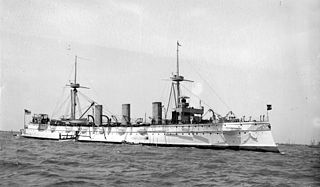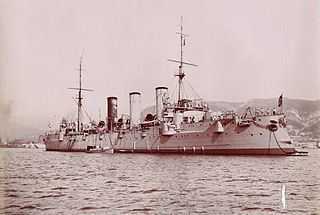
The Battle of the Falkland Islands was a First World War naval action between the British Royal Navy and Imperial German Navy on 8 December 1914 in the South Atlantic. The British, after their defeat at the Battle of Coronel on 1 November, sent a large force to track down and destroy the German cruiser squadron. The battle is commemorated every year on 8 December in the Falkland Islands as a public holiday.

SMS Dresden was a German light cruiser built for the Kaiserliche Marine. The lead ship of her class, she was laid down at the Blohm & Voss shipyard in Hamburg in 1906, launched in October 1907, and completed in November 1908. Her entrance into service was delayed by accidents during sea trials, including a collision with another vessel which necessitated major repairs. Like the preceding Königsberg-class cruisers upon which her design was based, Dresden was armed with ten 10.5 cm (4.1 in) SK L/40 guns and two torpedo tubes.

The German East Asia Squadron was an Imperial German Navy cruiser squadron which operated mainly in the Pacific Ocean between the mid-1890s until 1914, when it was destroyed at the Battle of the Falkland Islands. It was based at Germany's Jiaozhou Bay Leased Territory in China.

The siege of Tsingtao was the attack on the German port of Qingdao (Tsingtao) during World War I by Japan and the United Kingdom. The siege was waged against Imperial Germany between 27 August and 7 November 1914. The siege was the first encounter between Japanese and German forces, the first Anglo-Japanese operation of the war, and the only major land battle in the Asian and Pacific theatre during World War I.

Asian and Pacific theatre of World War I consisted of various military engagements that took place on the Asian continent and on Pacific islands. They include naval battles, the Allied conquest of German colonial possessions in the Pacific Ocean and China, an anti-Russian rebellion in Russian Turkestan and an Ottoman-supported rebellion in British Malaya. The most significant military action was the careful and well-executed Siege of Qingdao in China, but smaller actions were also fought at Bita Paka and Toma in German New Guinea.

Single-Handed is a 1953 British war film directed by Roy Boulting and starring Jeffrey Hunter, Michael Rennie and Wendy Hiller. It is based on the 1929 novel Brown on Resolution by C. S. Forester. Set largely in the Pacific, Hunter stars as a Canadian sailor serving on a British warship who battles single-handedly to delay a German World War II warship long enough for the Royal Navy to bring it to battle. The film was released in the United States as Sailor of the King.

Brown on Resolution is a 1935 film adaptation of the 1929 C. S. Forester novel Brown on Resolution, with John Mills in his first lead role playing the title role. The film is also notable for being the first film to use actual Royal Navy ships. The plot is centred on the illegitimate son of a British naval officer helping to bring about the downfall of a German cruiser during World War I.

SMS Kaiserin und Königin Maria Theresia was an armored cruiser used by the imperial Austro-Hungarian Navy from 1895 to 1917; she was the first ship of that type built by the Austro-Hungarian Navy. The ship was a unique design, built by the Stabilimento Tecnico Triestino shipyard in Trieste; she was laid down in July 1891, launched in April 1893, and completed in November 1894. Armed with a main battery of two 24-centimeter (9.4 in) guns and eight 15 cm (5.9 in) guns, the ship provided the basis for two subsequent armored cruiser designs for the Austro-Hungarian Navy.

SMS Kaiserin Elisabeth was a Kaiser Franz Joseph I-class protected cruiser of the Austro-Hungarian Navy. Named in honor of the Empress Elisabeth, consort of Emperor Franz Josef, the cruiser was designed for overseas service and in fact was stationed in China at the outbreak of World War I in 1914.

SMS Kaiserin Augusta was a unique protected cruiser, built for the German Kaiserliche Marine in the early 1890s. Named for Empress Augusta, who died in January 1890, she was laid down in 1890, launched in January 1892, and completed in November of that year. Owing to budgetary restrictions, Kaiserin Augusta was designed to fill both fleet scout and colonial cruiser roles. The ship was initially armed with a main battery of four 15 cm (5.9 in) and eight 10.5 cm (4.1 in) guns, which by 1896 was replaced with twelve new model 15 cm guns. She was the first ship in the German Navy to feature a three-shaft propeller arrangement.

The Battle of Más a Tierra was a World War I sea battle fought on 14 March 1915, near the Chilean island of Más a Tierra, between a British squadron and a German light cruiser. The battle saw the last remnant of the German East Asia Squadron destroyed, when SMS Dresden was cornered and scuttled in Cumberland Bay.

SMS Gefion was an unprotected cruiser of the German Kaiserliche Marine, the last ship of the type built in Germany. She was laid down in March 1892, launched in March 1893, and completed in June 1895 after lengthy trials and repairs. The cruiser was named after the earlier sail frigate Gefion, which had been named for the goddess Gefjon of Norse mythology. Intended for service in the German colonial empire and as a fleet scout, Gefion was armed with a main battery of ten 10.5-centimeter (4.1 in) guns, had a top speed in excess of 19.5 knots, and could steam for 3,500 nautical miles, the longest range of any German warship at the time. Nevertheless, the conflicting requirements necessary for a fleet scout and an overseas cruiser produced an unsuccessful design, and Gefion was rapidly replaced in both roles by the newer Gazelle class of light cruisers.

SMS Kaiserin was the third vessel of the Kaiser class of dreadnought battleships of the Imperial German Navy. Kaiserin's keel was laid in November 1910 at the Howaldtswerke dockyard in Kiel. She was launched on 11 November 1911 and was commissioned into the fleet on 14 May 1913. The ship was equipped with ten 30.5-centimeter (12 in) guns in five twin turrets, and had a top speed of 22.1 knots. Kaiserin was assigned to III Battle Squadron and later IV Battle Squadron of the High Seas Fleet for the majority of her career, including World War I.

SMS König Albert was the fourth vessel of the Kaiser class of dreadnought battleships of the Imperial German Navy. König Albert's keel was laid on 17 July 1910 at the Schichau-Werke dockyard in Danzig. She was launched on 27 April 1912 and was commissioned into the fleet on 31 July 1913. The ship was equipped with ten 30.5-centimeter (12 in) guns in five twin turrets, and had a top speed of 22.1 knots. König Albert was assigned to III Battle Squadron and later IV Battle Squadron of the High Seas Fleet for the majority of her career, including World War I.

The cruiserBogatyr, launched 1901, was the lead ship of the Bogatyr class of four protected cruisers built between 1898 and 1907 for the Imperial Russian Navy.

The German commerce raiders of World War I were surface vessels used by the Imperial German Navy for its Handelskrieg, a campaign against Allied seaborne trade. The ships comprised warships, principally cruisers, stationed in the German colonial empire before the war began, express liners commissioned as auxiliary cruisers and later, freighters outfitted as merchant raiders. These vessels had a number of successes and had a significant effect on Allied naval strategy, particularly in the early months of the war.

SMS Emden was the second and final member of the Dresden class of light cruisers built for the German Kaiserliche Marine. Named for the town of Emden, she was laid down at the Kaiserliche Werft in Danzig in 1906. The hull was launched in May 1908, and completed in July 1909. She had one sister ship, Dresden. Like the preceding Königsberg-class cruisers, Emden was armed with ten 10.5 cm (4.1 in) guns and two torpedo tubes.

SMS Cormoran was an unprotected cruiser of the Bussard class, the fifth member of a class of six ships. She was built for the Imperial German Navy for overseas duty. The cruiser's keel was laid down in Danzig in 1890; she was launched in May 1892 and commissioned in July 1893. Cormoran was armed with a main battery of eight 10.5-centimeter (4.1 in) guns, and could steam at a speed of 15.5 knots.

SMS Jaguar was the second member of the Iltis class of gunboats built for the German Kaiserliche Marine in the late 1890s and early 1900s, for overseas service in the German colonial empire. Other ships of the class are SMS Iltis, SMS Luchs, SMS Tiger, SMS Eber and SMS Panther.



















